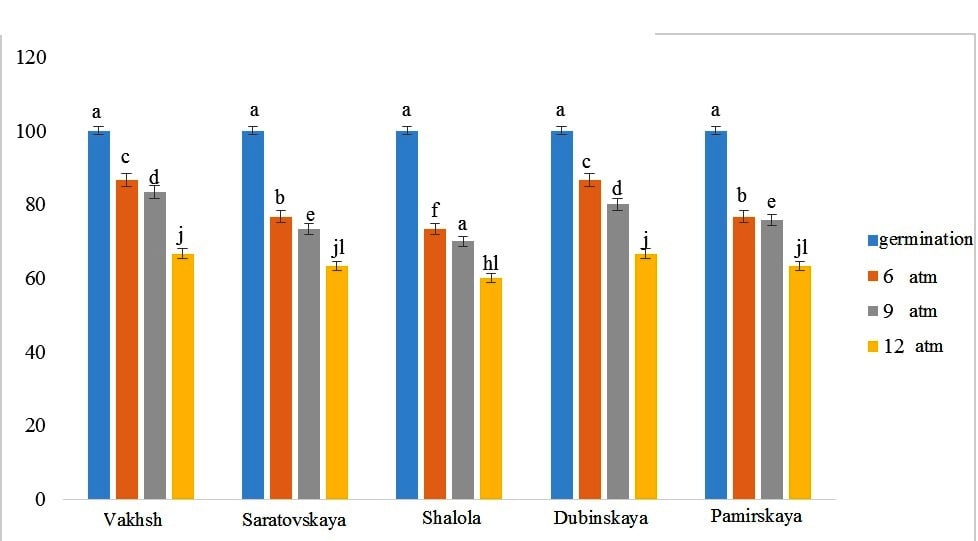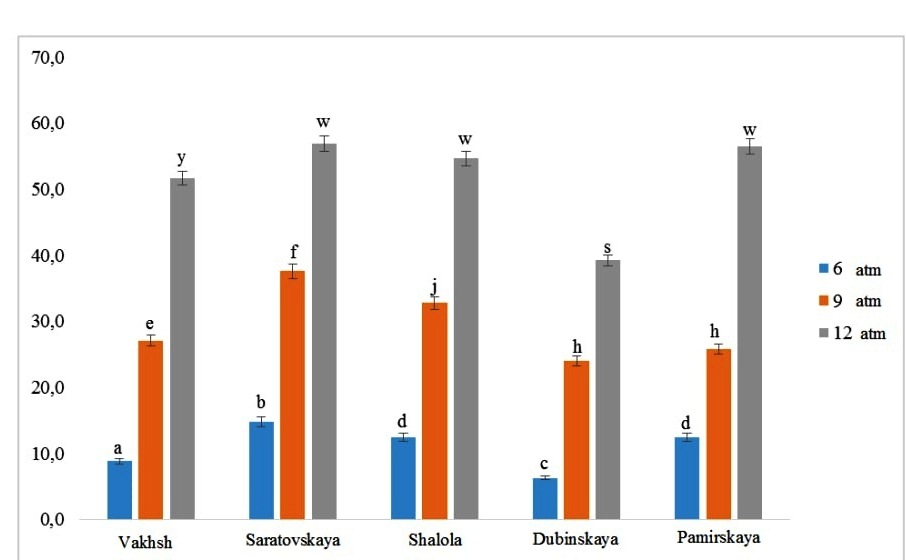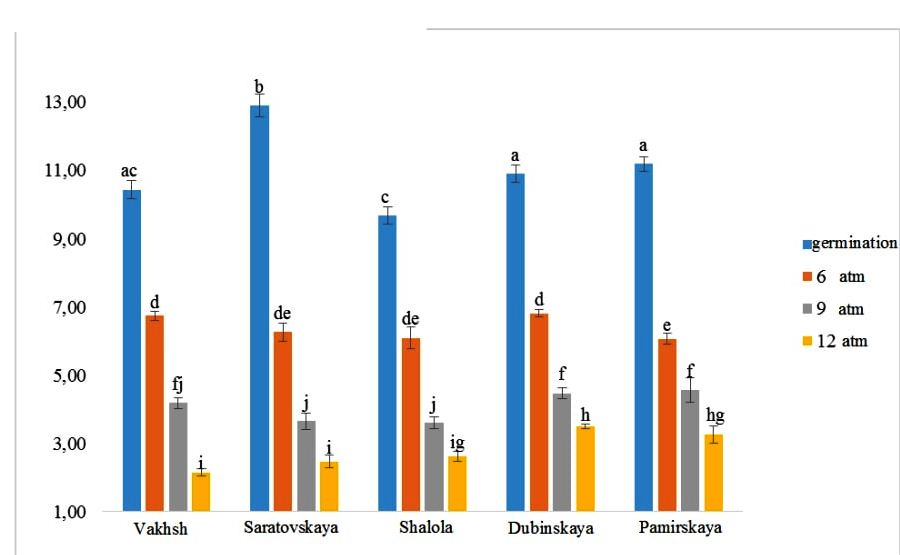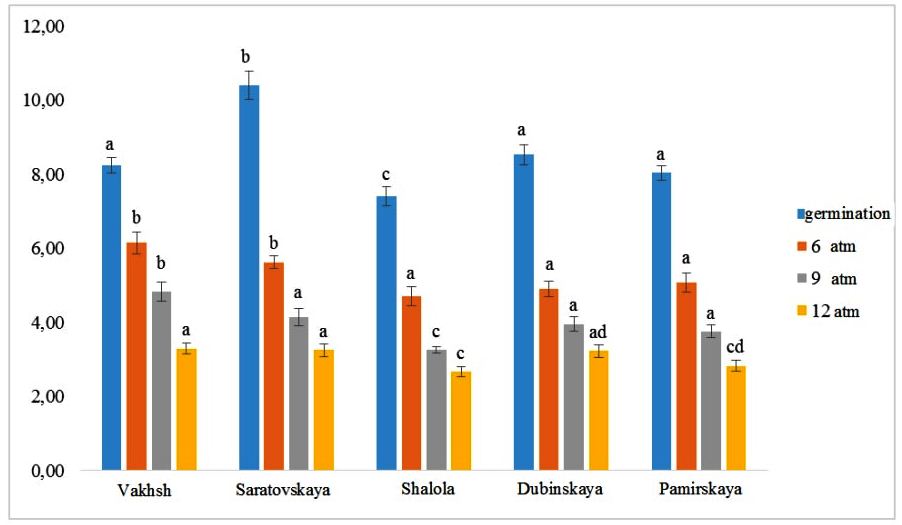-
Paper Information
- Paper Submission
-
Journal Information
- About This Journal
- Editorial Board
- Current Issue
- Archive
- Author Guidelines
- Contact Us
International Journal of Genetic Engineering
p-ISSN: 2167-7239 e-ISSN: 2167-7220
2022; 10(2): 24-28
doi:10.5923/j.ijge.20221002.03
Received: Aug. 26, 2022; Accepted: Sep. 19, 2022; Published: Oct. 14, 2022

Evaluation of Physiological Parameters of Autumn Rye (Secale Cereale L.) under Drought
Satipov G. M.1, Sapayeva G. A.2, Chinikulov B. Kh.3, Alloberganova Z. B.4
1Doctor in Agricultural Sciences, Urgench State University, Urgench, Uzbekistan
2Urgench State University, Urgench, Uzbekistan
3Laboratory of Molecular and Biochemical Genetics at the Institute of Genetics and Plant Experimental Biology of the Academy of Sciences of the Republic of Uzbekistan, Tashkent, Uzbekistan
4Doctor in Biological Sciences, Urgench State University, Urgench, Uzbekistan
Copyright © 2022 The Author(s). Published by Scientific & Academic Publishing.
This work is licensed under the Creative Commons Attribution International License (CC BY).
http://creativecommons.org/licenses/by/4.0/

In the article, the relative ability of five rye cultivars to measure different morpho-physiological parameters of drought tolerance, i.e. seed germination percentage, root length, shoot length and tolerance index were studied.
Keywords: Rye, Seed germination, Drought tolerance, Sucrose, Osmotic pressure, Biomass, Depression, Ear length, Number of grains per ear, Mass of 1000 grains
Cite this paper: Satipov G. M., Sapayeva G. A., Chinikulov B. Kh., Alloberganova Z. B., Evaluation of Physiological Parameters of Autumn Rye (Secale Cereale L.) under Drought, International Journal of Genetic Engineering, Vol. 10 No. 2, 2022, pp. 24-28. doi: 10.5923/j.ijge.20221002.03.
1. Introduction
- Drought resistance is one of the important biological and economically valuable characteristics of plants, which is the ability to use moisture in conditions of lack of moisture, especially in the first stages of growth and development [1]. The term “drought tolerance” refers to the ability of plants to withstand unfavorable growing conditions without reducing yield [2]. Winter rye is relatively drought-resistant and is a water-efficient crop due to its well-developed root system. However, the lack of moisture in each of the important periods of water use (germination stage, autumn processing, from the emergence of the tube to the ear, the period of grain filling) slows down the processes of morphogenesis and decreases the parameters of productivity, including the length of the ear, the number of grains in the ear, the weight of 1000 grains. In addition, dry weather during the period of sprouting and flowering reduces the readiness of crops for wintering [3]. In regions with sufficient moisture, the negative effects of drought on agricultural crops are more pronounced than in dry regions. In the years with a moisture deficit during the periods of increased water demand of the plants, the yield of autumn rye is significantly reduced, which determines the relevance of the research conducted to evaluate the relative drought resistance of the cultivated varieties [4].
2. Materials and Methods
- Indirect methods of assessing relative drought resistance include the method of determining the germination of seeds in a solution with increased osmotic pressure that simulates a lack of water (for example, sucrose solution). Cultivars that can germinate under osmotic stress and develop a strong primary root system can subsequently be drought tolerant under natural field conditions [5]. This method makes it possible to isolate promising drought-resistant material at the early stages of organogenesis, which is important for the cultivation of autumn drought-resistant winter crop varieties [5]. The concentration of the osmotic solution should be such that the differences in the stability of the evaluated objects have the largest amplitude [6]. Correctly selected concentration gives a clearer picture of the relative drought resistance of the varieties.For research, five autumn rye varieties – Vakhsh, Pamirskaya, Dubinskaya, Saratovskaya and Shalola were selected. The sample size consists of 30 seeds of each variety. Seed germination was carried out in Petri dishes on filter paper. In the experimental variants, sucrose solutions of different concentrations were added to the cups and osmotic pressures of 6, 9, and 12 atmospheres (atm) were created: In the control variant, the seeds were collected with the addition of distilled water. On the tenth day, the germination of seeds was determined (P, %). For this, the number of seeds that gave the root of the minimum length in the experimental and control variants was counted, and then the average number of germinated seeds in sucrose solution (a) was expressed as a percentage compared to the number of germinated seeds. In control (b), that is, P = (a/b) × 100%. The higher the percentage of seed germination in the sucrose solution, the more drought-resistant the sample is.
3. Result and Discussion
- As a result of studying the germination of seeds of Vakhsh, Pamirskaya, Dubinskaya, Saratovskaya and Shalola varieties under different water deficit conditions (different concentrations of sucrose solution), it was found that the germination varies from 60.0% to 86.7%, depending on the conditions and genotype. According to the results of the analysis, it was found that there are statistically significant differences in the degree of seed germination according to the factor “variety” and “concentration of sucrose solution” (Fig. 1).
 | Figure 1. Effect of different levels of osmotic pressure on winter rye seed germination |
 More drought-resistant samples are characterized by less depression of growth processes at high osmotic pressure, which is manifested by less decrease in biomass accumulation by seedlings.In our research, the confidence interval of the value of the seed germination characteristic was determined for each sample when differentiating according to the level of drought tolerance, and then the group interval value was calculated.Evaluation of the depression of dry biomass accumulation in the experiments of Vakhsh, Pamirskaya, Dubinskaya, Saratovskaya and Shalola varieties using the Fisher test of the StatView program showed that they had statistically significant differences compared to the 6, 9 and 12 atm options. It turned out that the Dubinskaya variety was less depressed than other varieties in all variants (Fig. 2).
More drought-resistant samples are characterized by less depression of growth processes at high osmotic pressure, which is manifested by less decrease in biomass accumulation by seedlings.In our research, the confidence interval of the value of the seed germination characteristic was determined for each sample when differentiating according to the level of drought tolerance, and then the group interval value was calculated.Evaluation of the depression of dry biomass accumulation in the experiments of Vakhsh, Pamirskaya, Dubinskaya, Saratovskaya and Shalola varieties using the Fisher test of the StatView program showed that they had statistically significant differences compared to the 6, 9 and 12 atm options. It turned out that the Dubinskaya variety was less depressed than other varieties in all variants (Fig. 2). | Figure 2. Depression of autumn rye varieties during growth |
 | Figure 3. Effect of different levels of osmotic pressure on the development of winter rye cultivars |
 | Figure 4. Effect of different levels of osmotic pressure on root length of winter rye cultivars |
4. Conclusions
- The laboratory method of growing winter rye seeds in sucrose solution allows indirect assessment of samples for drought tolerance. With the increase in solution concentration and osmotic pressure, a decrease in the percentage of seed germination was noted in all studied samples.The analysis of varieties carried out according to the established methodology allows to divide winter rye varieties into groups. Samples with less depression in osmotic stress can be considered promising for further study of drought tolerance under natural field conditions.
 Abstract
Abstract Reference
Reference Full-Text PDF
Full-Text PDF Full-text HTML
Full-text HTML